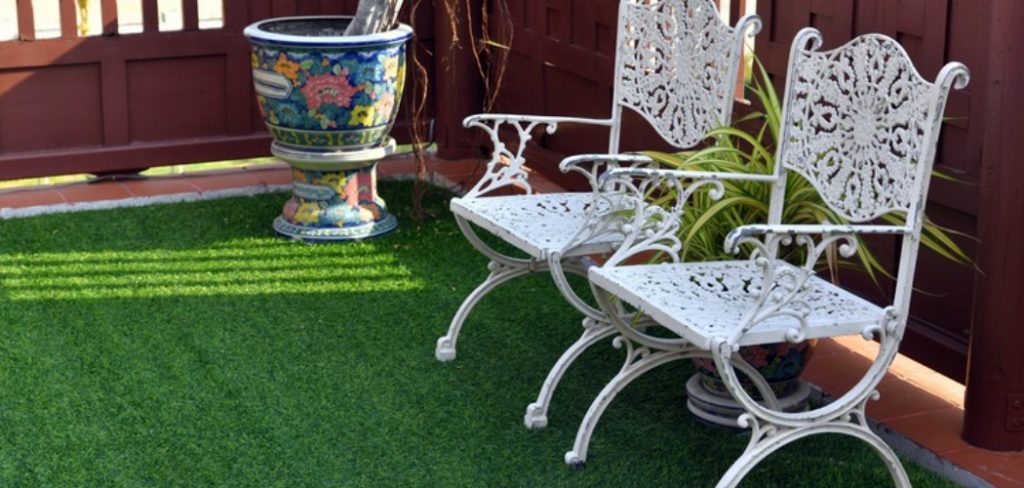Are you struggling to revive your old and rusty wrought iron furniture? Don’t worry, we’ve got you covered! Many people face the same problem with their iron furniture due to the changes in climate and other environmental factors.

Wrought iron furniture is a timeless and durable addition to any home or outdoor space. However, over time, exposure to the elements, wear and tear, or neglect can lead to rust, chipped paint, or a dull appearance. Reviving wrought iron furniture not only restores its original charm but also enhances its longevity, ensuring it continues to be both functional and stylish.
This guide on how to revive wrought iron furniture will walk you through the essential steps and techniques to bring new life to your wrought iron pieces, making them look as good as new.
What Are the Benefits of Reviving Wrought Iron Furniture?
Before we dive into the step-by-step guide, let’s first highlight some of the benefits of reviving your wrought iron furniture.
- Cost-effective: Rather than splurging on new furniture, reviving your old wrought iron pieces can save you a significant amount of money.
- Environmentally Friendly: By restoring instead of replacing, you are reducing waste and minimizing your carbon footprint.
- Personalization: Reviving your wrought iron furniture allows you to personalize it according to your taste and style.
- Durability: Wrought iron is known for its strength and durability. By reviving it, you can prolong its lifespan and continue enjoying its benefits for years to come.
- Preserving History: If your wrought iron furniture has sentimental value or is a family heirloom, reviving it can help preserve its history and memories.
What Will You Need?
To revive your wrought iron furniture, you will need a few basic tools and materials:
- Wire Brush or Sandpaper: To remove rust and old paint
- Protective Gear: Such as gloves, goggles, and a mask to protect yourself from dust and chemicals
- Rust Converter or Primer: To prevent future rusting
- Paint: For a new coat of color
- Clear Sealant: For added protection against the elements
- Screwdriver or Wrench: In case any parts need to be tightened or replaced
These items can easily be found at your local hardware store or online.
8 Easy Steps on How to Revive Wrought Iron Furniture
Step 1. Prepare Your Workspace:

Begin by choosing a well-ventilated area to work in, such as an open garage, a backyard, or a patio. This ensures proper airflow, especially if you’re working with chemicals or paint, and prevents inhaling harmful fumes. Lay down a protective covering, such as a drop cloth or old newspaper, to catch debris, rust flakes, and paint drips.
Make sure the workspace is free of clutter to avoid accidents and provide easy access to your tools and materials. If you’re working outdoors, check the weather forecast to ensure dry conditions, as humidity or rain can interfere with the task. Organizing your workspace prior to starting makes the entire process smoother and more efficient.
Step 2. Clean the Furniture:
Start by removing any loose dirt, dust, or cobwebs from the furniture using a dry brush or a vacuum with a brush attachment. Next, use warm water and mild detergent to clean the surface thoroughly. Scrub gently with a sponge or soft cloth to remove grime and residues, paying close attention to hard-to-reach corners and crevices. For stubborn stains or stuck-on dirt, you may use a nylon scrub brush for extra cleaning power.
Once cleaned, rinse the furniture with clean water and allow it to dry completely before moving on to the next step. Proper cleaning ensures a smoother restoration process and better results.
Step 3. Sand the Surface:

Once the furniture is completely dry, prepare it for restoration by sanding the surface. Use medium-grit sandpaper (around 120-150 grit) to remove any old paint, varnish, or imperfections. Sand in the direction of the wood grain to avoid scratches or damage. For detailed or intricate areas, consider using a sanding block or a detail sander for precision.
After sanding, switch to fine-grit sandpaper (220 grit or higher) to smooth the surface further, ensuring a clean and even finish. Wipe away any dust or debris with a tack cloth before proceeding to the next step. Sanding creates an ideal surface for paint, stain, or sealant to adhere effectively.
Step 4. Apply Primer or Stain:
With the surface prepped and cleaned, the next step is to apply a primer or stain, depending on the desired finish. If you plan to paint the furniture, start with a high-quality primer to ensure even coverage and better adhesion of the paint. Use a brush or roller designed for the type of primer you are using, and apply it in thin, even layers.
Allow the primer to dry completely as per the manufacturer’s instructions. If you prefer to enhance the natural beauty of the wood, opt for a wood stain instead. Apply the stain evenly using a clean cloth or brush, working it into the wood grain. Remove any excess stain with a dry cloth to avoid blotches and allow for proper drying before sealing or finishing.
Step 5. Apply Paint or Sealant:

Once the primer or stain has dried completely, it’s time to apply your chosen paint or sealant. If painting, select a high-quality paint suitable for furniture and apply it in thin, even coats using a brush or roller. Allow each coat to dry thoroughly before applying the next to achieve a smooth and durable finish. Typically, two to three coats are recommended for optimal coverage.
For a natural finish, use a clear sealant such as polyurethane or varnish to protect the wood. Apply the sealant evenly with a brush, ensuring complete coverage, and allow it to dry as per the product’s instructions. Sand lightly between coats for a professional-quality result.
Step 6. Reassemble and Enjoy:
After the paint or sealant has completely dried, carefully reassemble the furniture if it was disassembled during the preparation process. Ensure all parts are securely attached and any hardware is tightly fastened. Once reassembled, your refinished furniture is ready for use. Place it in your desired space and admire the refreshed look you’ve achieved through your hard work and attention to detail. Remember to maintain the finish over time by cleaning with appropriate products and avoiding abrasive materials.
Step 7. Maintain Your Furniture:
To ensure the longevity of your refinished furniture, establish a regular maintenance routine. Use gentle cleaning products specifically designed for the type of finish you’ve applied, and avoid harsh chemicals that could damage the surface. Protect your furniture from direct sunlight, excessive moisture, and extreme temperature changes, as these factors can cause fading, warping, or deterioration over time. Adding felt pads to the bottom of furniture legs can also prevent scratches on floors and extend the life of your piece. With proper care, your refinished furniture will maintain its beautiful appearance for years to come.
Step 8. Enjoy Your Furniture:

Now that your furniture has been refinished and properly maintained, it’s time to enjoy the fruits of your labor. Incorporate it into your living space, letting it complement your décor and serve its function beautifully. Take pride in knowing that you’ve not only given a tired piece a second life but also contributed to a more sustainable lifestyle by repurposing instead of discarding.
By following these steps and taking your time, you can achieve professional-looking results and transform any old piece of furniture into a stunning addition to your home.
5 Things You Should Avoid
1. Skipping Proper Cleaning: Before starting any restoration process, neglecting to clean the furniture thoroughly can lead to unsatisfactory results. Dirt, rust, and debris can interfere with paint adhesion and make the final finish uneven.
2. Ignoring Rust: Failing to address existing rust can compromise the integrity of the wrought iron. Always remove rust completely using a wire brush or sandpaper before applying any coatings or paint.
3. Using the Wrong Paint: Applying paint that is not specifically designed for metal surfaces can lead to peeling and chipping. Always use rust-resistant metal paint for better durability and aesthetics.
4. Overlooking Protective Coatings: Skipping a protective sealant or coating at the end of the process may leave the furniture vulnerable to moisture and further rust. A clear topcoat is essential for long-term protection.
5. Rushing the Process: Not allowing adequate time for cleaning, drying, and curing between steps can lead to poor results. Patience is key to achieving a well-restored piece that lasts.
Can You Use Vinegar on Wrought Iron?
Yes, vinegar can be used on wrought iron furniture as a cleaning agent. It is a natural and effective way to remove rust and stains from the surface.
However, diluting the vinegar with water before using it is important, as pure vinegar can be too acidic and potentially damage the metal. It is also recommended to test a small area first before applying it to the entire piece of furniture.
Additionally, after cleaning with vinegar, make sure to thoroughly rinse and dry the furniture before proceeding with any further steps in the restoration process.
Conclusion
How to revive wrought iron furniture requires careful attention to detail and a step-by-step approach.
By thoroughly cleaning the surface, addressing rust with suitable tools and solutions such as vinegar, and applying a high-quality primer and paint, you can restore its original charm and durability. Always ensure to allow proper drying and curing times between steps, and finish with a clear protective coat to safeguard the furniture against moisture and rust in the future.
With patience and the right methods, your wrought iron pieces can be transformed into stunning and long-lasting functional decor once again.

Professional Focus
Oliver Wood, a passionate patio designer, specializes in creating comfortable and inviting outdoor spaces that enhance relaxation and entertainment. His work combines a deep understanding of design with a love for nature, making him a standout professional in the field of outdoor living spaces. Through his thoughtful approach, he transforms everyday patios into extraordinary retreats for family and friends.
About the Author
Oliver Wood, a skilled patio designer, shares his expertise on outdoor living through his designs and insights. With a background in patio design and a genuine passion for creating beautiful spaces, he encourages others to invest in their outdoor environments, enhancing their homes with functional and inviting spaces for relaxation and entertainment.
Education History
University: Virginia Union University
Oliver’s education equipped him with the knowledge and skills to design patios that merge aesthetics with comfort, transforming outdoor areas into beautiful extensions of the home.
Expertise:
- Patio Design and Outdoor Living Spaces
- Functional and Aesthetic Landscaping
- Comfortable and Inviting Outdoor Environments
- Design Philosophy for Family-Oriented Spaces
- Creating Spaces for Relaxation and Entertainment
